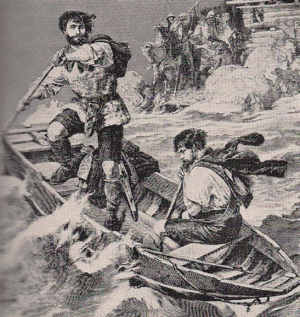 SKC Films Library |
| SKC Films Library >> Switzerland >> Federation and Independence, 1291-1516 |
| William Tell hero of the Swiss movement for independence from the Austrian Habsburgs According to legend, William Tell was a man of tremendous strength and was the most skilled crossbow marksman in Swiss canton of Uri, which in Tell's day was under the control of Austrian bailiff Gessler, who represented the Count of Habsburg. Gessler had ordered all Swiss to bow to a hat he had set up on a pole in the main square of Altdorf. Tell refused to bow, however, and was arrested. Knowing of Tell's skill with the crossbow, Gessler promised that he would let Tell go free if he could shoot an apple off his own son's head. Tell was successful, but then produced another arrow from under his cloak. When asked why he had another arrow, Tell said that he had planned to use it against Gessler if he hit his son instead of the apple. An infuriated Gessler had Tell seized and chained. William Tell shooting an apple off
his son's head Gessler planned to take Tell across Lake Lucerne towards his castle at Küssnacht, but as they reached the center of the lake a storm came up and began violently rocking the boat. Knowing that only Tell possessed the strength to steer the boat through the waves to shore, Gessler allowed him to take the rudder. Tell easily guided the boat to shore, got off the boat, and then pushed it back into the storm, with Gessler aboard; Gessler managed to survive, however. Some time later, as Gessler was traveling between his castle and Immensee, Tell ambushed Gessler and shot him through the heart. This act inspired the Swiss to rise up in rebellion against the Austrian Habsburgs, leading to the establishment of the Swiss Confederation, on August 1, 1291. Tell steering the boat through a
storm Although William Tell is the official National Hero of Switzerland, no historical account of him has ever been uncovered. The first mention of Tell did not appear until 1470, when he appeared as a character in a chronicle called White Book of Sarnen. A few years later he became the central figure in a ballad singing the praises of the beginning of the Swiss Confederation. His hero status was further heightened by the publication of the drama Urner Tellspiel about a generation later. Aegidius Tschundi elevated Tell to a real person in his Chronicon Helveticum (History of Switzerland), published in 1734. The William Tell story did not become popular, however, until German poet Johann Friedrich von Schiller published William Tell in 1804, and Gioacchino Rossini produced the opera William Tell in 1829. Despite there being no actual historical record that William Tell (or any similar hero) ever existed, his legend inspired revolutionary movements across Europe, especially in France, Russia and Spain. The monument shown above was erected by Richard Kissling in Tell's "hometown" of Altdorf in 1895, and a chapel stands at the site where Tell was supposed to have escaped from Gessler's boat, near Sisikon. |
| SKC Films Library >> Switzerland >> Federation and Independence, 1291-1516 This page was last updated on 06/09/2018. |

